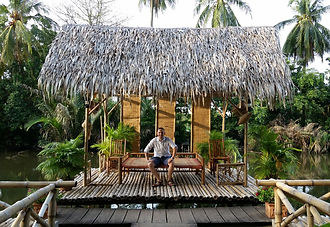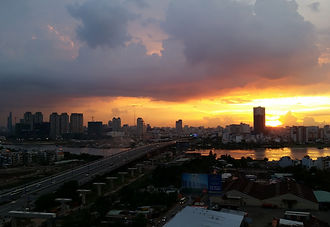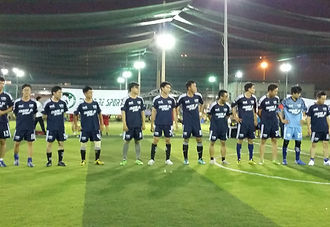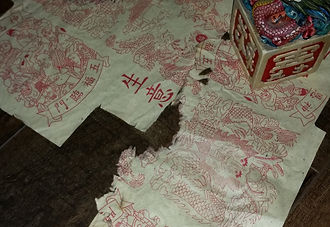Designed by artist Sy Hoang and opened in 2014, the Áo Dài Museum is more than just a museum. Guests will experience 20,000 square meters of multiple wooden beam houses and expansive outdoor grounds of serene gardens and waterways. The houses display ao dai dresses from past to present, sculpture and pottery, and a variety of other Vietnamese artifacts. The Áo Dài Museum is a high-quality display of Vietnamese history and a relaxing getaway from the bustling HCMC (about 45 minutes from city center by car).
Bình Quới Village is indeed "touristy," but nevertheless, a fun and interesting display of Vietnamese culture. The attraction comprises two sections (Bình Quới 1 and Bình Quới 2), both exemplifying village life in the Mekong Delta region. Guests can walk through the extensive garden grounds, filled with swings, flowers, coconut trees, creeks & streams, and cottages. The village serves Vietnamese cuisine in traditional outdoor market style, and at the floating restaurant. The village is most enjoyable and lively on the weekends, with more vendors and cultural shows.
Just around the corner from the Central Post Office, Nguyen Van Binh Street is now permanently known as "Book Street." Visitors will find numerous shops filled with new books and souvenirs, and used books on tables down the middle of the street. There are a few cafes, great for people-watching or reading. During the Tet holiday (Lunar New Year), you can find additional vendors, such as calligraphers and artists.
Located in central HCMC in District 1, the Central Mosque is a visual reminder of the religious diversity in Saigon. The mosque was built in 1935, and is one of twelve in HCMC. It is open for visitors and worshippers from 6:00am to 9:00pm.
Built in the late 19th century, the Central Post Office is both a functioning post office and a tourist attraction. The building is picturesque both outside with its grandiose Gothic-Renaissance-French design, and inside with two large old maps and one large portrait of Ho Chi Minh. Also inside, tourists can find souvenir shops, tour agency booths, ATMs, and post office staff who can assist with domestic and international mail & shipping.
Chợ Lớn (literally translated to "Big Market") is HCMC's Chinatown. Here you'll find the city's largest indoor/outdoor market, which sells truly anything and everything, including fabrics, clothing, baskets, kitchen accessories, toys, fresh food, packaged food, the list goes on. As overwhelming as the market might sound, it is worth a visit to experience the expanse of sold goods. And a plethora of delicious street food to try, too. Beyond the market in the surrounding neighborhood, you'll find numerous pagodas, and Chinese restaurants and shops.
Chợ Tân Định is yet another indoor/outdoor market, selling a variety of food and items, but best known for its selection of fabrics. If you can't find what you're looking for in the market, check out the surrounding shops on Hai Bà Trưng. Feeling hungry after shopping? Go to Quan Banh Xeo 46A or any of the stalls in the market.
Abou an hour drive from HCMC city center, the Củ Chi Tunnels encompass a huge network of underground tunnels used by the Viet Cong during the Vietnam War. Recommend you book a private day trip tour through an agency (e.g. Asian Trails). The agency will pick you up from Ho Chi Minh City, drive you to Cu Chi, and provide a tour of the tunnels. Visitors have the opportunity to go into the tunnels and to shoot a variety of guns from the Vietnam War. The half-day tour is interesting and memorable, and worth the travel time and cost.
The Fito Museum is six floors and 18 exhibition rooms of items related to traditional Vietnamese medicine, dating back to the Stone Age. Items include tools, pharmacy equipment, books & documents, among many others. Vietnomnomnom's favorite characteristic of the museum is its mix of traditional and modern architecture, reflecting features from the North, from Hue, from the Cham people, and from the South. The Fito also houses a gift shop with unique souvenir options.
The Independence Palace (a.k.a. Reunification Palace) was the home of the Southern Vietnamese government during the Vietnam War. Many will recognize it from the iconic photographs of the fall of Saigon on April 30, 1975, when a North Vietnamese tank crashed through the gate. Now, the Palace serves as a museum. Guests can see some of the original furniture and room set-ups, the helicopter pad, the radio control rooms, and the unique architecture, designed by Ngô Viết Thụ. Though not air-conditioned, the palace is a nice break from the sun, and an interesting and inexpensive way to spend a couple of hours in Saigon.
In 1909, the Chinese community in Saigon built the Jade Pagoda in honor of the highest Taoist god, the Jade Emperor (a.k.a. the King of Heaven a.k.a. Ngoc Hoang). Vietnomnomnom recommends this pagoda to tourists for its unique and mysterious atmosphere, and its countless and intricate statues and carvings.
Saigon has numerous public parks, but Vietnomnomnom's favorite is Công Viên Lê Văn Tám. This park is constantly filled with exercisers, musicians, and dancers. Le Van Tam is especially fun at night when you can find ballroom dance classes and lively music.
Many bars in Saigon now host live music, but there are a few dependable, go-to spots for talented and fun musicians. Typically, live music in the city consists of popular cover music from the 70s, 80s, 90s, and 2000s, with a Vietnamese or Filippino twist. Most performers are indeed Filippino, which means guaranteed effortless musical talent. The number of other expat musicians is also growing, and can be found throughout the city. Check out Vietnomnomnom's list of Best Live Music venues.
Traders from Tamil Nadu (the Nagarathar) built the Mariamman Temple in the late 19th century to honor the Hindu goddess Mariamman (the goddess of rain). The temple has an impressive number of statues and relics. Moreover, it exemplifies the beauty of Hindu temples, and the wide religious diversity in the city of Ho Chi Minh.
A Mekong Delta tour is a must-do for those visiting Saigon for an extended period of time. Visitors can choose from half-day, full-day, or overnight options. For a half or full day excursion, Vietnomnomnom recommends a Ben Tre tour, which includes off-the-beaten-path visits to coconut and brick-making factories, a boat ride through the Delta, and lunch in the jungle. For an overnight option, be sure to visit Ben Tre, spend the night in Can Tho, and then experience the floating market in the early morning.
A motorbike tour is one of the best ways to experience and to see Saigon from a local perspective. Guests will see the popular tourist sites, the endless shops, the countless cafes and restaurants, and most importantly, will truly feel the controlled chaos of traffic. Tours can be customized to be culture-focused, food-focused, or a combination of the two, and guests can choose to ride in the morning, the afternoon, or the evening. Be sure to use a company that is open about their safety and insurance policies, and wear a helmet!
Nguyễn Huệ Street is a pedestrian street sandwiched between numerous bars, restaurants, cafes, and the People's House. The walkway is filled with fountains, lights, music, and a statue of Uncle Ho. The action on Nguyen Hue all happens in the evenings, when groups of young Vietnamese congregate to sing songs, dance, play in the fountains, and, of course, take selfies. For a nice overhead view of the street, dine at SH Garden, or have a drink at the Rex Hotel or Broma.
Constructed by French colonists between 1863 and 1880, the Notre Dame Cathedral is one of the most beautiful landmarks of Saigon. In fact the building is usually surrounded with numerous brides and grooms taking their wedding photos. The cathedral has opening hours of 05:30-17:00; however, often the building is closed to visitors at random times. To visit the inside, it's best to go during Sunday mass, on Sundays at 09:30.
Designed by French architect Eugène Ferret, the Saigon Opera House was built in 1897. From 1956 to 1975, the building was used as the home of the Lower House assembly of South Vietnam. It re-opened as a theater in 1975, and restored in 1995. The building is beautiful inside and outside, and the shows are affordable and impressive. Vietnomnomnom recommends the AO Show, in particular, though any performance at the Opera House will be sure to entertain and to display the theatrical side of Saigon culture.
Though a bit mainstream "touristy," a river cruise is a relaxing lunchtime or evening activity, and a beautiful way to experience the Saigon River. Though the quality and variety of food is typically mediocre, the ambiance is enjoyable. Vietnomnomnom recommends the cruise as a one-time experience, and for those looking for ways to beat the heat and to give the feet a rest.
Saigon is well-known for its countless rooftop bars and restaurants, truly a must-do while visiting the city. Visitors can choose from more low-key full-dining options, like the Secret Garden or Mountain Retreat, or more trendy, upscale bars like Air 360 or Glow. The upscale rooftop bars typically have a more relaxed, "lounge" ambiance before 9pm, and afterwards, the bars become disco, club-like settings (with a DJ, etc.). Check out Vietnomnomnom's list for Saigon's Best Bars or Saigon's Best Restaurants for more rooftop options.
Saigon is the home of many up-and-coming fashion designers and crafters, and many of these artists have established their own brick-and-mortar shops. These shops are constantly opening and closing, so it may be difficult to find an up-to-date "best shops list". Vietnomnomnom recommends simply walking around District 1 and hopping in any boutique that looks appealing to your taste (duh). Popular streets include Ly Tu Trong, Dong Khoi, and Nguyen Trai. Vietnomnomnom favorites include Cong, Magonn, Thuy, Phuong My, Thuc, 3A Station, Sadec, Authentique, and the Maker.
Shopping (Market)
Visiting a local market is an absolute must-do when visiting Saigon. Visitors can buy truly anything in these markets from clothing to souvenirs to food (groceries or prepared). Bến Thành Market is the most popular for tourists, and is a good choice for first-timers, as vendors typically speak some English, and the diversity of options is endless. Chợ Bến Thành is closed in the evenings, but vendors open tents on the surrounding streets for a night market experience. Vietnomnomnom's favorite markets are Chợ Tân Định, Chợ Thị Nghè, or Chợ Lớn, for more off-the-beaten-path experiences. We also recommend experiencing markets with a local guide (either by foot or on motorbike) to get the most out of the visit.
Sporting Event
Attending a local sporting event is great way to get to know and to connect with locals in Saigon. Vietnomnomnom recommends Saigon Heat basketball games or Saigon Raiders football (a.k.a. soccer) games. Or, stop by any local stadium and watch an amateur game, just as lively and fun.
The options for spas and massages in Saigon are affordable and endless. Vietnomnomnom recommends to spend a little more to ensure a high quality, hygenic experience. Our favorite is Sài Gòn Đẹp, which has two locations, one in Thao Dien in District 2, and the other in District 1 near 23/9 Park. For an all-day spa experience, try Anna Sanctuary Wellness Spa, or Thann Sanctuary Spa.
Located a 30 minute drive outside of HCMC city center, Suối Tiên Park is a fun half- or full-day activity for families or anyone looking for a unique Southeast Asia experience. The park offers a variety of activities, including high and low intensity amusement park rides, games, food, shows, temples, cultural and spiritual relics, and a water park (for an additional fee). That being said, Vietnomnomnom recommends this activity primarily for its one-of-a-kind, amusing, and ostentatious factors. The quality and safety standards are generally low, compared to mainstream amusement parks, but still, fun to experience and great for people-watching.
While Hoi An is known for its tailors, Saigon, too, has endless (and perhaps more affordable) options. Vietnomnomnom recommends bringing a picture (or a copy) of exactly what you want made. You can either bring your own fabric (purchased at Tan Dinh or any local market), or the tailor can provide. Check out reviews of the tailor before arriving, and know that tailors near Ben Thanh Market and the backpackers district will be higher priced (but can do quick turnarounds). Don't hesitate to negotiate price - tailor competition is high in the city, so you can always stroll down to the next tailor. Allow time for one or two fittings before your city departure. Some tailors require a partial deposit, but we recommend pushing for payment upon completion, if possible.
Urban Tales is a half-day tour of Saigon's Cho Lon (Chinatown) with a fun murder mystery, scavenger-hunt twist. Participants are challenged to solve the murder case of Dr. Lam, leading them to discover off-the-beaten path sites, temples, shops, and relics in the Chinese quarter. It's a self-guided tour, but the game is designed to provide ample directional instruction, and the Urban Tales staff is a simple phone call away. The game ends with lunch at a Chinese restaurant, where the food is good, though not the best Chinese food in the city. Nevertheless, overall a unique and memorable way to experience a different part of Saigon.
Established in 1975, the War Remnants Museum contains exhibits related to the Vietnam War and to the first Indochina War. The museum is on all the "must-do" lists for HCMC, and Vietnomnomnom agrees. Though a one-sided, and some times exaggerated illustration of Vietnam's history, the perspective is interesting and important to understand as a visitor or resident of Saigon. Note - there are some unique memorabilia shops just outside of the museum's exit (still on museum property). Also note that the museum closes during lunchtime.
Flea markets in Saigon are indoor/outdoor markets, selling vintage and/or hand-crafted clothing, accessories, collectibles, decor, and artwork. Vendors are young, entrepreneurial Saigoneers, and the items are unique and fun to peruse. Many of the markets also sell snacks and food, and have live entertainment. Flea markets are all over the city, and some of a specific theme. Vietnomnomnom's favorites are Saigon Flea Market, The New District, Hello Weekend Market, and the Saigon Urban Flea Market. Check out their social media pages for opening hours and locations.
Check out Vietnomnomnom's Itinerary: 3 Days in Saigon
Photo credits: TripAdvisor, company websites, and Vietnomnomnom.
































